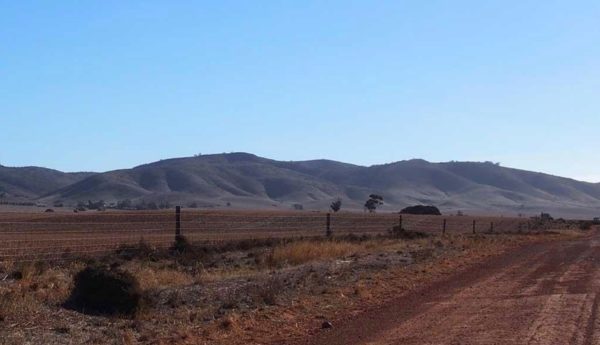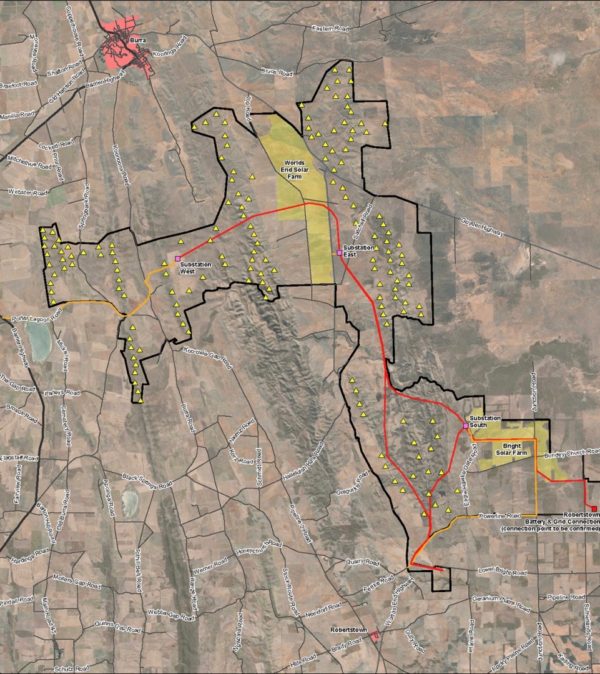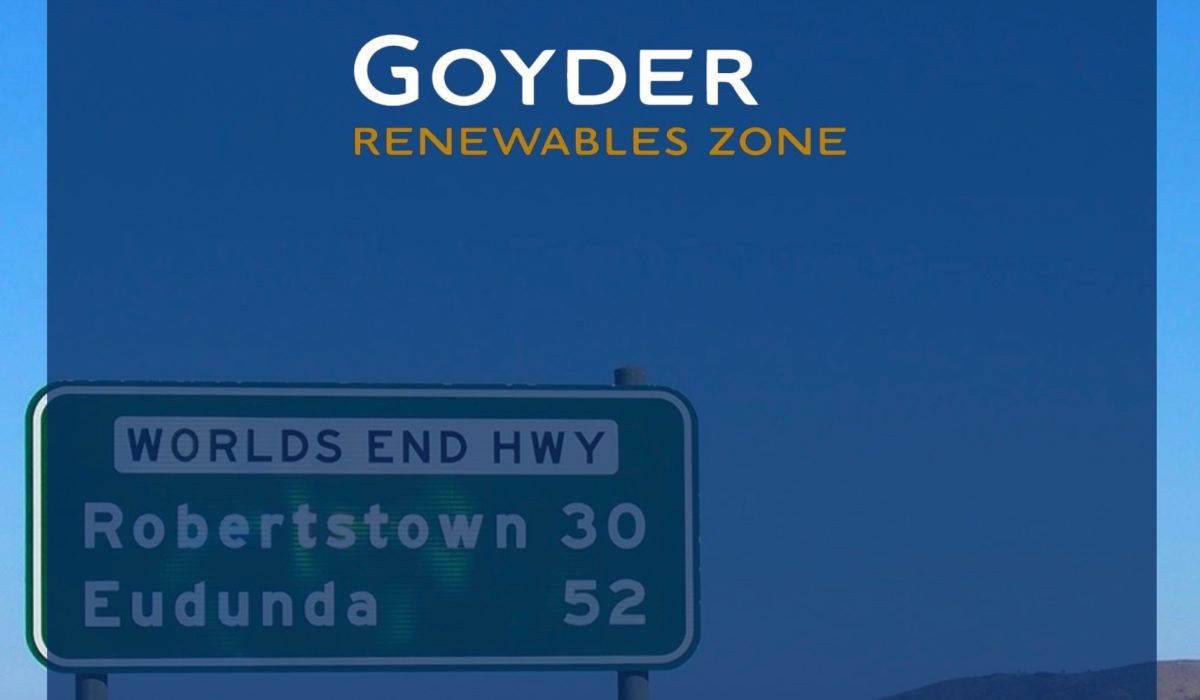In September 2019, French renewables giant Neoen announced plans for a massive hybrid power plant in South Australia (SA) featuring 1200 MW of wind, 600 MW of solar, and 900 MW/1,800 MWh of battery storage. The project would rely on the yet-to-be-built SA-NSW Interconnector. Today, Neoen announced the commencement of the notification period for this, its proposed Goyder South Hybrid Renewable Energy Facility.
The project, which Neoen expects will cost at least $3 billion, is being proposed for Worlds End, 18km south of Burra, SA, around Baldina, Bright, and Koonoona, on the traditional lands of the Ngadjuri Nation. Neoen says that the Goyder region is “home to some of the best wind and solar resources in the country.” Neoen proposes to take advantage of these resources with one integrated wind, solar, and energy storage project “capable of delivering a steady, reliable, dispatchable output of power throughout the day and night.”
Neoen says that its firm renewable facility will provide “reliable power at a cost which would likely be lower than any other renewable or conventional fossil-fuelled generator in Australia – even taking into account the additional cost of battery storage.”

Image: Neoen
The Proposed Project
This is what Neoen is proposing as the main features of the project:
- A wind farm of up to 163 turbines with a capacity of up to 1200MW, a maximum hub height of 160m, a maximum blade length of 80m and an overall maximum height (tip height) of 240m;
- A solar farm (across two sites) of up to 3000 ha of solar panels with a capacity of up to 600MW;
- An energy storage facility (lithium-ion battery) with a capacity of up to 900MW/1,800MWh (2 hours);
- Associated infrastructure for connection to the electricity grid including three substations, access tracks, underground connection cabling and transmission lines;
Because of the project’s massive size, Neoen is proposing staggered phases of construction. These stages are by no means set in stone, indeed, they’re highly dependent on the size and type of the demand from electricity customers. However, Neoen tentatively approximates three separate stages, each seeing the construction of 400 MW of wind, 200 MW of solar and 300 MW/600 MWh of storage.
Pending approval of the project, and the long amount of time needed for financial close on a project of this size, Neon estimates the stages could each take 3-6 years or approximately 12 years for the completion of the entire project from the date of approval.

Image: Neoen
For an in-depth analysis of the project’s feasibility, see here.
That’s not the half of it
The Goyder South Hybrid Renewable Energy Project is staggering in its size, for example, the project suggests that its quantity of bifacial solar panels would take up 3,000 hectares, approximately the size of the nation of Tuvalu.
These panels would be separated into two separate farms, the Bright Solar Farm, and the Worlds End Solar Farm, both consisting of between 800,000-1,000,000 panels.

Neoen estimates the Goyder South Project would generate more than 4,800,000 MWh of power annually, saving 2,112,000 tonnes of CO2 each year, the equivalent of taking 872,000 cars off the road, or planting 39,360,000 trees.
But Neoen has said that the Goyder South Project is itself part of the larger Goyder Renewables Zone (GRZ), a concept project Neoen has been developing since 2017 covering both Goyder North and Goyder South, divided by Burra, and for which Neoen intends to submit a separate Development Application.
This is all to say, what Neoen is proposing is not just a massive renewable project, but a tale of two cities, a colossus with two enormous renewable feet planted either side of the proposed EnergyConnect interconnector.
Energy storage
Neoen proposes that its “extremely large battery” be located at the SA end of the future EnergyConnect line and provide much the same grid support as Neoen’s Hornsdale Power Reserve does currently, specifically noting Hornsdale’s role in the recent disruptions of February 2020.
The battery’s key role however, “would be to allow Goyder South to provide ‘hedge’ contracts to consumers such as industrial customers or electricity retailers.” This is to say that big customers can be guaranteed fixed power prices 24 hours a day, “irrespective of regional spot price fluctuations. This reduces the risk of power price fluctuations to large, energy-intensive industries and businesses such as mines, smelters, manufacturers and retailers.” Neoen believes that its renewable energy will allow it to undercut the hedge contract market traditionally dominated by fossil fuel generators.
“By combining energy production and storage,” says Neoen, “Goyder South would overcome the conventional critique of renewables that they are ‘intermittent’ and ‘unreliable’. Hybrid projects such as this are the natural ‘next step’ in the transition to a cleaner, cheaper, renewable economy.”
SA-NSW Interconnector Dependence
The feasibility of the project is entirely dependent on the successful construction and operation of Project EnergyConnect (PEC), the SA-NSW Interconnector. PEC, led by ElectraNet and TransGrid, is a 900km, 330kV above-ground interconnector proposed to run between Robertson, SA, and Wagga Wagga, NSW. TransGrid has been pushing strongly for this project for over three years as a way to provide “energy security to SA and unlock new renewables generation in south-west NSW.”
As David Dixon, Senior Analyst in Australian Renewables Research at Rystad Energy, told pv magazine: “If the transmission line does not get built, it will be hard to justify such scale for the relatively small SA market (with limited export capacity to VIC).”
Of course, it must also be noted that while the Goyder South project is entirely dependent on the SA-NSW Interconnector, the two are actually inter-dependent. It is projects of the scale of Goyder South that act as major drivers for PEC, as demonstrated by the Project Assessment Conclusions Report (PACR) published by ElectraNet for the SA Energy Transformation RIT-T.
This content is protected by copyright and may not be reused. If you want to cooperate with us and would like to reuse some of our content, please contact: editors@pv-magazine.com.









5 comments
By submitting this form you agree to pv magazine using your data for the purposes of publishing your comment.
Your personal data will only be disclosed or otherwise transmitted to third parties for the purposes of spam filtering or if this is necessary for technical maintenance of the website. Any other transfer to third parties will not take place unless this is justified on the basis of applicable data protection regulations or if pv magazine is legally obliged to do so.
You may revoke this consent at any time with effect for the future, in which case your personal data will be deleted immediately. Otherwise, your data will be deleted if pv magazine has processed your request or the purpose of data storage is fulfilled.
Further information on data privacy can be found in our Data Protection Policy.